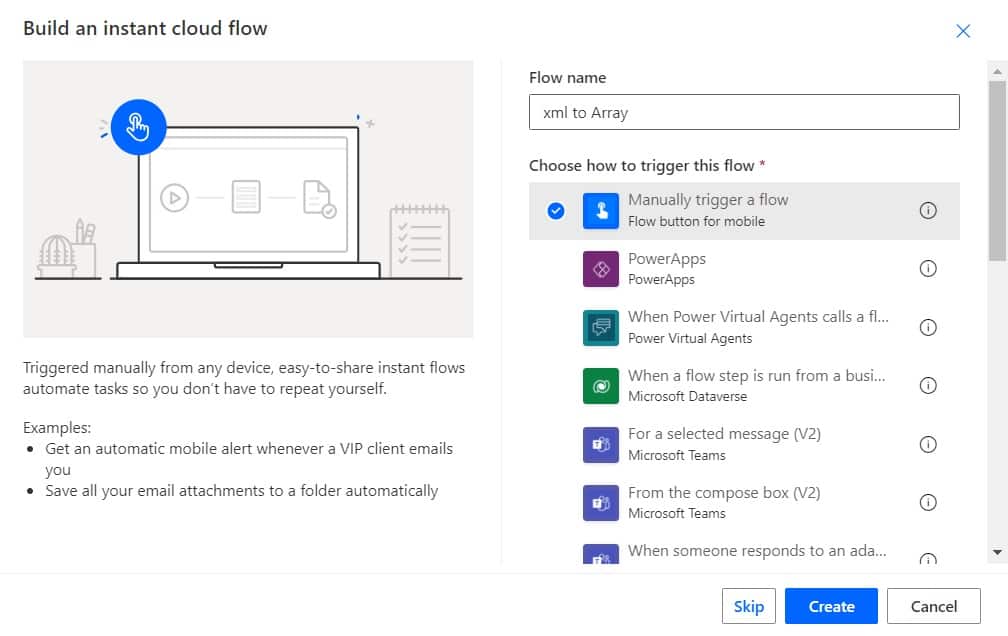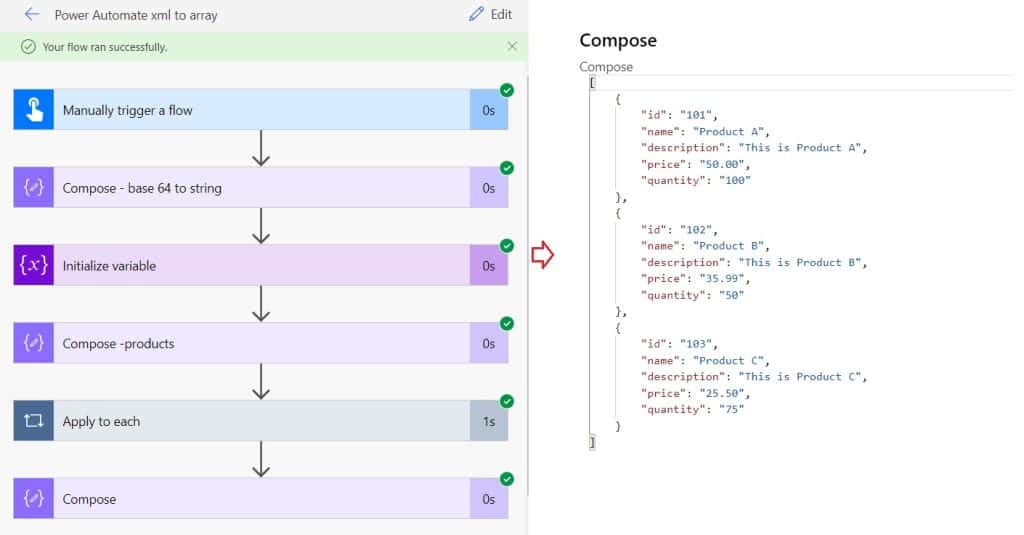This Power Automate tutorial will show how to convert XML to an array in Power Automate or Microsoft Flow.
For example, we will create a flow that will convert the given XML file content to an array, by parsing the XML file content, like below.

For this, we will create an Instant cloud flow in Power Automate, that will take an XML file as user input. Then parse the file content of that XML file, loop through each node of XML data, and append to an array.
How to convert XML to an array using Power Automate
Here we will see how to convert an XML to an array using Power Automate.
Let’s create an Instant cloud flow, that will convert XML to an array using Power Automate.
Step 1: Log in to Power Automate and click the +Create icon in the left navigation -> select Instant Cloud Flow.

Then provide the flow name, and select the Manually trigger a flow. Then click on Create.

Next, you can see Manually trigger a flow is added to the flow page. Then we will add the file as user input, so click on the +Add an input -> select File options.

Step 2: Now we will convert the base64 to string using Power Automate, so, click on the +New step -> select Compose action. Then provide the below information:
- Inputs: Provide the below expression:
base64ToString(triggerBody()?['file']?['contentBytes'])
Step 3: Next, click on the +New step, and select Initialize variable action. Then provide the below information:
- Name: Provide the variable name.
- Type: Select the type as an Array.

Step 4: Now, we will parse the XML data, so, click on the +New step -> select Compose action. Then provide the below information.
- Inputs: Provide the below information:
xpath(xml(outputs('Compose_-_base_64_to_string')), '/products/product')
Step 5: Now we will loop through person nodes to get the details, so click on the +New step -> select Apply to each action. Provide the below information:
- Select an output from previous steps: Select the output of the previous compose, from the dynamic content.
Next, we will Add an action -> select Compose action, then provide the below information:
- Inputs: Provide the below expression
items('Apply_to_each')?['$content']After that, click on Add an action -> select Compose action to convert base64 to string, then provide the below information:
base64ToString(outputs('Compose_4'))
Step 6: Now, click the +New step -> select Append to array variable action. Then provide the below information:
- Name: Select the variable name.
- Value: Provide the below information:
{
"id": @{join(xpath(xml(outputs('Compose_5')), '/product/id/text()'),'')},
"name": @{join(xpath(xml(outputs('Compose_5')), '/product/name/text()'),'')},
"description": @{join(xpath(xml(outputs('Compose_5')), '/product/description/text()'),'')},
"price": @{join(xpath(xml(outputs('Compose_5')), '/product/price/text()'),'')},
"quantity": @{join(xpath(xml(outputs('Compose_5')), '/product/quantity/text()'),'')}
}
Step 7: Now we will use compose action to check the result so, click on the +New step -> select Compose action and then provide the below information:
- Inputs: Select the variable person details from dynamic content.

Step 8: Now, to test the flow, click on Save and then click on the Test icon ->select the Manually option -> click on the Test button. Then click Import and select the XML file -> click on Run flow. You can see your flow run successfully.
The XML data is converted to an array in Power Automate.

This is how we can convert XML to an array using Power Automate.
Conclusion
In this Power Automate tutorial, we will see how to convert XML to an array using Power Automate.
You may like the following Power Automate tutorials:
- How to loop through XML data and insert into Excel using Power Automate?
- How to send email from excel using Power automate?
- Send an email with options in Power Automate
I am Bijay a Microsoft MVP (10 times – My MVP Profile) in SharePoint and have more than 17 years of expertise in SharePoint Online Office 365, SharePoint subscription edition, and SharePoint 2019/2016/2013. Currently working in my own venture TSInfo Technologies a SharePoint development, consulting, and training company. I also run the popular SharePoint website EnjoySharePoint.com